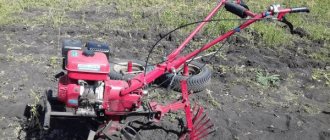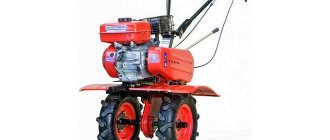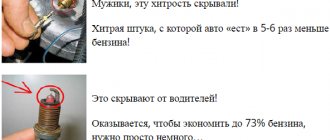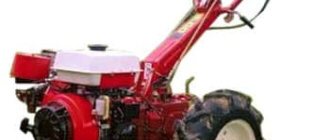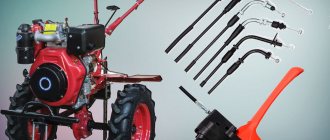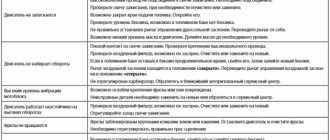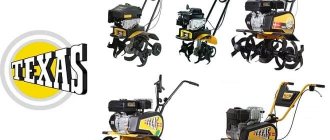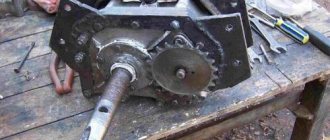The Khoper brand has a very fancy name, but is Russian. This brand appeared on the market not so long ago - in 2010, during which time it occupied its niche in the garden equipment segment and became one of the leaders among its competitors. The Khoper line includes several gasoline and diesel models of cultivators and walk-behind tractors.
The devices are manufactured in China, while assembly is carried out in Russia. Most of the brand’s models are copies of devices from Zirka and Kadvi. But in terms of reliability, Khoper walk-behind tractors are not inferior to the originals, while in terms of cost they are more profitable, which sets them apart from other market offerings.
The successful combination of reliability, efficiency and affordable price makes Khoper brand equipment popular among amateur gardeners and professional farmers. Among the company’s other offerings, we should highlight the Khoper 900 walk-behind tractor, owner reviews of which you can read in the article, which will allow you to make your choice.
Model description
The above-mentioned equipment option is one of the popular walk-behind tractors among Russians. The equipment can be combined with attachments, which increases its versatility. The walk-behind tractor allows you to:
- hill up potatoes;
- harrow the plowed soil;
- mow the grass;
- sweep paths;
- transport dug crops;
- plow the soil;
- dig up ripe crops;
- plant potatoes;
- remove snow.
The described model is very functional; it can be used almost year-round, replacing equipment that is designed to perform a specific number of tasks. The device is easy to operate, so you can prepare it for use yourself. The motor power is enough to process an area whose area does not exceed 1 hectare.
One of the advantages of this technique is the ability to adjust the width and depth of processing, because these parameters can change depending on specific tasks. Another feature of the Khoper 900 walk-behind tractor, the owners’ reviews of which you can read below, is a reliable transmission, which provides the ability to travel in one of three speeds. Thanks to this, the device is very maneuverable, and the operator, while controlling it, will be able to return to missed areas.
The model has a belt clutch, which is easy to maintain. The walk-behind tractor copes well with heavy soil. It can be used for removing frozen snow and processing virgin soil. The design has a compact size, which allows the equipment to move between obstacles and plow soil in hard-to-reach places.
The design of the device is quite simple. You can control the walk-behind tractor with maximum comfort using the adjustment knob, moving it up and down and from side to side. Rubber wheels have an impressive size, which allows them to overcome obstacles and move off-road.
The Khoper 900 walk-behind tractor, owner reviews of which often force consumers to incline their choice towards this model, is equipped with a reliable Lifan 168 engine, which has sufficient power to perform most operations. With the help of a metal bracket you can transport equipment. The device has a casing that protects the operator from flying soil.
How to assemble a cutter for a walk-behind tractor
Currently, the process of cultivating land takes much less time than half a century ago. Modern manufacturers of agricultural machinery offer a wide variety of all kinds of equipment designed to make the work of farmers and land owners automated. For example, a walk-behind tractor is a type of compact and multifunctional special equipment designed to solve various problems associated with cultivating small areas of land. The walk-behind tractor itself is a basic unit, which is equipped with additional equipment. Later in this article we will figure out how to assemble a cutter for a walk-behind tractor and achieve the maximum level of its performance.
User manual
In order for the Khoper walk-behind tractor to last as long as possible, it must be run in after purchase. This procedure should be performed in several stages. First, you need to check the fuel and oil levels. And then the equipment is started and left to idle for 10 minutes.
Then you should pause and turn on the walk-behind tractor again. After 20 minutes, you will be able to begin performing more complex tasks. The manufacturer recommends testing all gears and choosing the optimal position. If you read the instructions for the Khoper 900 walk-behind tractor, you will be able to understand that after an hour of work you can begin transporting or cultivating the soil.
It is recommended to try all equipment. The run-in will last approximately 12 hours. During this time, it is better not to subject the walk-behind tractor to increased load. The equipment should not overheat. After this, the engine is washed and the oil is changed.
Saber cutter and its assembly
Before assembling the cutters on a walk-behind tractor, you need to thoroughly understand the concept of a walk-behind cultivator. This is a welded frame made of pipes with a diameter of more than 23 mm with a fuel tank and engine installed on it. They are fixed to the frame with brackets. The engine is otherwise called the power unit. It is equipped with a gearbox and clutch mechanism. Any brand of cultivator has its own unit with varying power.
In most cases, the cutter has a saber shape. This scheme is the most popular these days, which is why it is also called standard. The effectiveness of saber-shaped knives has been confirmed by many years of use on soils of different compositions. Installing such cutters on a walk-behind tractor allows you to do a huge amount of work. The strength of knives made from carbon steel is very high. The design of the cutter is collapsible. Each knife undergoes thermal hardening with high-frequency currents during the production process.
How are cutters for walk-behind tractors assembled? It doesn’t matter which cutter consists of 2 blocks. Each of them contains 12 cutters. The block consists of 3 nodes. Each node is 4 legs located at right angles (image). They are placed at an angle of 30° relative to each other. Each knife is made of steel 5 mm wide. They are attached to a stand, which is made of a corner measuring 63x40 mm. The other end of the stand is welded to the flange in such a way as to connect 4 knives together. All parts of the cutter are connected together with bolts, washers and flanges. This design is very reliable. It is capable of withstanding quite high loads. If you plan to use the cultivator all the time, it is better to install an industrial cutter.
READ Operation of the Neva MB 2 walk-behind tractor
Some craftsmen encounter difficulties when installing a cutter on a walk-behind tractor Therefore, it is recommended to do this work together. Assembly is usually done on specially made wooden trestles about 50 cm high. They help to cope with the work more quickly. The walk-behind tractor carefully rests on the ploughshare and tilts at an angle of about 45°. Traces are placed under the steering wheel handle. In this position, the wheels are removed from the walk-behind tractor and cutters are installed (image). At the outer ends on the right and left, it is necessary to install plates on cutters for a walk-behind tractor. They improve the properties of the unit, making its operation more stable and smooth.
Specifications
The described Russian-made walk-behind tractor has outstanding technical characteristics, including a fairly impressive processing width, which reaches 1200 mm. You can go 300 mm deep into the ground. The technology can reach speeds of up to 8 km/h. The length, width and height of the structure are 1300 x 550 x 1100 mm respectively. The equipment weighs 75 kg.
Looking at the technical characteristics of the Khoper 900 walk-behind tractor, you can understand that the equipment is equipped with a four-stroke gasoline engine, which is manufactured in China. This unit is the most common in the field of garden equipment. It was specially designed for non-professional class walk-behind tractors. The motor combines low cost, efficiency, reliability and simplicity.
Crow's feet cutter
This product is more youthful and modern. It is mainly used for working on hard soils. It is recommended to work only on weed-free soil and on a level place. Even with the arrival of autumn cold, the results of the work are very excellent. How to assemble a crow's foot cutter? You need to prepare some tools and materials:
- iron tube with a diameter of 42 mm;
- parts for loosening the earth;
- welding machine;
- grinder with discs.
The basis of rippers can be old car springs. They are cut into pieces of suitable length and welded to a pipe that acts as a base. The edges of the knives are sharpened and welded to this pipe. After assembling the entire mechanism, a test run is performed. During it, the necessary adjustments are made. When starting the walk-behind tractor, the cutter blades should hang in the air without touching the ground. They must be lowered slowly. Only then the cutter work for a long time.
Making crow's feet requires some training in metalworking. The knives require forging, and not every owner of the unit can do this. If is assembled , it may break. The design of the crow's feet is non-separable. This gives it additional strength. Product properties:
- weight - about 16 kg;
- operating speed - 2-5 km/h;
- assembly width - 41 cm;
- length and height - 38 cm.
The knives are self-sharpening. If worked carefully, they no longer require sharpening. With all this, it is necessary to position the edges of the petal correctly. They should go into the ground with a sharp end. With the correct adjustment of the knives, the ground is plowed to a depth of 30 cm. To achieve this result, they first go along the site, then across it.
Additional engine characteristics
Lifan 168 has an oil level sensor and an automatic decompressor. The motor is protected from dry operation thanks to an oil control system, which extends the life of the device. As for the decompressor, it is necessary to reduce the starting effort.
The unit has a cooling system that provides forced air injection. The valves are located vertically. The engine displacement is 196 cm3. The design provides for the presence of one cylinder. The rated power is 6.5 liters. With. Average fuel consumption is 394 g/kWh, which is approximately 1.6 l/h. The fuel tank holds 3.6 liters. If you want to purchase a Khoper 900 walk-behind tractor, the price of this equipment should interest you. You can purchase the device for 26,600 rubles.
Types of cutters for walk-behind tractors
The cutters for a walk-behind tractor may differ from each other in shape and design, the number of knives and their location. They are installed at the rear of the motorcycle and depend on the power take-off shaft. Soil tillers give the best results when the speed of movement increases.
The general design of the cutter can be characterized as a set of tillage blade knives placed at different angles on blades welded or secured with fasteners to a rotating axis.
READ Simple adapter for a walk-behind tractor with your own hands
Milling cutters. How to assemble correctly? Motoblock Hopper 900MQ
The blades smoothly and alternately enter the soil, which has a beneficial effect on the transmission of the walk-behind tractor.
- active, or saber-shaped;
- crow's feet.
Consumer Reviews
According to users, after purchasing even a small plot of land, purchasing a walk-behind tractor becomes a necessity. You will be able to dig up the soil using this equipment, because doing such work manually is quite tedious and takes a lot of time.
If you want to save money, it is better to purchase a walk-behind tractor in winter; it is recommended to do this after the January holidays. Running in equipment, according to owners of private lands, is not labor-intensive, and it can be completed in the shortest possible time. After this, you can immediately start working.
The description of the Hopper 900 walk-behind tractor will allow you to understand that this equipment has a fairly powerful engine, so the device will be able to cope even with heavy soil. Fuel consumption is acceptable. It is better to refuel the equipment with AI-92 gasoline. You may also be interested in the ease of starting the unit. As home craftsmen assure, you can start the device in one try, less often in three. For small areas this unit is an excellent option.
Is it necessary to sharpen cutters for a walk-behind tractor?
Any tillers are self-sharpening tools. Sharpening is not necessary for them, as it can only ruin the design. Only in some cases, if you have been using a cutter for a very long time and see that it has begun to work the ground poorly, you can sharpen the knives.
The tiller is an important element of each unit. Homemade, correctly assembled cutters can be used on any modern walk-behind tractor, in particular on Neva MB 1 and MB 2, MTZ and others. Such structures will help in cultivating the land and make agricultural tasks easier.
READ Is it possible to fill a walk-behind tractor with 95 gasoline?
Choosing cutters for a walk-behind tractor is a responsible process, because this element plays an important role in ensuring the efficiency of the device. In order to choose the right cutters, you need to understand the distinctive features of these products, understand what types and types of cutters exist.
Cost of spare parts
No matter how high-quality the equipment is, it may need spare parts. For example, you can purchase a wheel hub for 720 rubles. But the pulley for the engine costs 340 rubles. You can buy a set of transport wheels for RUB 3,890.
When considering spare parts for walk-behind tractors, you should compare their costs. For example, an adapter will cost 995 rubles. But the assembled wheel costs 1990 rubles. You can buy a tire and wheel tube for 1,690 rubles. The control knob will cost 3,000 rubles.
How to assemble a saber cutter on a walk-behind tractor
Installing a cutter on a walk-behind tractor is not at all difficult, but first you need to assemble it correctly, setting the desired direction of rotation: the sharpened part of the mechanism must cut into the soil.
The walk-behind tractor should be leaned against the coulter, and then tilted approximately 45 degrees. Then you need to place the trestles under the steering wheel handle and simply remove the wheel.
Assembling a cutter for a walk-behind tractor is a process that can be mastered fairly quickly, but before you begin, you should decide on the functions that the finished unit should perform. If you decide to assemble the cutter yourself, you should first make a rough drawing. After assembly, it is necessary to test the unit and make appropriate adjustments to its design, if necessary. The assembly diagram of the cutters on the walk-behind tractor will allow you to understand the design of the unit in more detail.
Additional consumer opinions on operational features
Buyers who have already enjoyed the quality of the described equipment note that the engine is capable of operating even at low temperatures. The walk-behind tractor can handle soil cultivation in one pass on wet soil. But if you have to work with black soil or heavy soil, then the equipment may not achieve the goal the first time. Some areas, according to consumers, have to be processed 6 times, which makes it possible to break up the lumps.
Owner reviews of the Khoper 900 walk-behind tractor indicate that fuel consumption is very economical. If your site is located on a slope, then you can have no doubt and purchase the described walk-behind tractor model. She will be able to cope with processing such an area quite quickly.
According to some buyers, over several years of operation the machine has caused almost no trouble. You don’t have to resort to repairs so often; problems can only arise with the belt. For some consumers, the dimensions mentioned above are quite impressive, which can negatively affect maneuvering and storing equipment.
Attachments
To expand the functionality of the walk-behind tractor, you can use the following equipment:
- mowers for efficient grass harvesting in a short time;
- weighting agents that increase the weight of the device and are used for cultivating particularly dense soil;
- harrows for loosening the soil;
- potato planters and potato diggers for planting and collecting root crops;
- hillers, loosen the soil around the seedlings;
- dump shovels for clearing snow-covered areas;
- lugs are installed instead of wheels and facilitate movement on viscous and wet soil, and also prevent slipping;
- trolleys are adapted for transporting goods.
General information
Please note that almost all components of the walk-behind tractor are made in China. Finished parts are delivered to Russia for final assembly. It is worth noting that the model range of the Khoper company, which includes the Khoper 900 itself, is largely unified and copied with the original walk-behind tractors from the famous companies Kadvi and Zirka. But despite this, the Hopper 900 is in no way inferior to its “ancestors”. At the same time, the cost of the model is much lower compared to the originals.
Multiagro
The Multiagro gearbox is a special version of the mechanism that was patented specifically for the Neva. It has a number of features:
- the number of gears has been increased;
- the gear ratio is increased, which allows for increased traction with little power consumption;
- The wheels (right and left) are separated, which is necessary for a minimum radius when turning. This allows for significantly increased maneuverability;
- resistance to increased loads using a more powerful body, which is reinforced with stiffening ribs on the inside of the body;
- the casing is sealed using a special silicone-based sealant;
- the shape has a streamlined appearance, which reduces resistance when cultivating the soil.
All these features allow the walk-behind tractor to gain additional capabilities that are often unavailable to competitors.
This gearbox was made specifically for the Neva walk-behind tractor
What kind of oil should be poured into the gearbox?
When it comes to the question of what kind of oil to pour into the gearbox of a walk-behind tractor, the most reliable option is to rely on the manufacturer’s recommendations. They are outlined in the instruction manual, and if it is lost, the text can be easily found on the Internet. In general, any transmission oil is used to lubricate the gearbox. It is not advisable to mix oils to avoid conflict between additives. In rare cases, when mixed, substances can turn the entire lubricant into an emulsion, which can lead to gearbox failure or, at a minimum, a thorough rinsing of it. Therefore, before adding new oil, you should check for the presence of old oil.
Which one is better to choose?
As mentioned earlier, there are several types of oils for walk-behind tractors. It is necessary to use the liquid recommended by the manufacturer of the unit - to do this, just carefully study the labeling of the device and read the instructions.
In addition, each individual type of oil is divided according to its chemical composition into several types. In most cases, manufacturers try to manufacture units with the ability to use the most common types of oils - synthetic, mineral, and semi-synthetics, for example, Mannol Molibden Benzin 10W40 or SAE 10W-30.
READ Walk-behind tractor engine does not start reasons
It is worth noting that this lubricant contains a friction modifier, which creates a durable film on the inner surface of the parts. This significantly reduces the wear rate of the walk-behind tractor.
Another marking that should not be forgotten is the designation of the operating properties of oils. It also has several varieties. For example, category C is used for 4-stroke diesel engines, and category S is used for gasoline engines.
From these data a certain conclusion can be drawn. Considering the engine types, a high level of demand is directed towards all-season oils labeled 5W30 and 5W40. Among anti-corrosion oils, 10W30 and 10W40 are popular.
At temperatures above 45 degrees, oils marked 15W40, 20W40 should be used. For winter cold, it is necessary to use oil fluid 0W30, 0W40.
In the engine
The primary oil change in the internal combustion engine occurs after 28-32 hours of operation. The next replacement can be made no more than 2 times a year - in summer and winter, even if the unit has been standing for some time without operation. To begin the replacement process itself, you need to prepare special attributes - a funnel and a container for draining the waste liquid.
At the bottom of the engine there is a hole with a cap through which old oil can be drained. A drain container is placed in the same place, the locking cap is unscrewed, and the waste liquid is drained. It is necessary to wait some time for the residue to completely drain from the engine system. The plug is then screwed into place and fresh oil can be added.
Its quantity should be identical to the drained amount. If it is not possible to take measurements, it is better to look at the technical data sheet of the unit, where the required number in grams is indicated. After new oil has been poured into the engine, it is necessary to check its level. To do this, just use a special probe.
It is worth noting that in some engines that are sensitive to oil fluids, for example, Subaru or Honda, it is assumed that they use oils of a certain class, that is, SE and higher, but not lower than the SG class.
This instruction is general for both two-stroke and four-stroke models. More specific information on how to replace the oil fluid in a walk-behind tractor is best considered in the instructions for a specific unit.
Advantages of working with cutters
The Grasshopper mounted rototiller is a type of agricultural equipment used for cultivating and loosening soil. The tool ensures the creation of the most suitable conditions for obtaining a high-quality and rich harvest. Among the advantages of this mechanism, one can highlight its versatility: for example, the equipment copes well with milling work, is used for crumbling soil after frost, mixing layers of soil, grinding plant humus, and killing weeds.
Nothing extra: just assembly of cutters for walk-behind tractor and motor-cultivator
The website of the manufacturer Grasshopper presents the widest range of modern high-quality special equipment designed to make working with the soil easier, faster and more productive. We are engaged in the production and sale of only high-quality gardening, construction and agricultural equipment.
Sources:
https://crast.ru/instrumenty/kak-pravilno-sobrat-frezy-na-motoblok-video https://stroy-dvorik.ru/motobloki/kak-sobrat-kultivator-na-motoblok-video.html https: //grasshopper.land/infocenter/kak-sobrat-frezu-dlya-motobloka.html
Model range of cultivator "Texas"
The Texas range of cultivators consists of several lines:
- The Mini line of units is designed for small plots, greenhouses and conservatories; among cultivators it includes the Tex 204R.
- The El-Tex line of lightweight electric cultivators comes in 740, 1400 and 2000 watt models. These units are intended only for prepared land; plowing virgin soil is prohibited.
- The Texas Hobby cultivator is presented in three medium models: 380 TG, 500 TGR, 600 BR. They differ in the installed engine: models 380 and 500 have a power unit with a power of 2600 watts, and the “six hundredth” - 4100.
- The LX line is designed for heavy soils, the 550TG model has a 3600 kW motor.
- The TX line is also not afraid of difficult soils over large areas. The TX 601B and 601 TG models differ in their engines, and the TX 602 unit differs in the steering device.
- Even a woman can handle the Lilly series cultivator, which is lightweight but without loss of functionality. Models 572 V, 530 TG, 532 TG, 534 TG are equipped with a powerful enough engine for working on heavy soils.
- The Futura line, which includes the 6003B and 6003 TG models, works intensively on large areas with a 4100 watt motor.
- The Fusion line is practically mini-tractors—heavy, productive agricultural machines.
Basic faults
Malfunctions are inevitable in the operation of any walk-behind tractor. Next, we will look at the main types of faults in Hopers and possible ways to eliminate them on your own. If the malfunction is serious and your knowledge is not enough to eliminate it, contact a specialized repair center or service (with a valid warranty).
Gearbox
Main problems with the gearbox and how to fix them:
- noise in the gearbox (check the oil level, add; do not use low-quality oil);
- oil leakage from the gearbox (check the condition of the seals, eliminate the gap, adjust the oil level, filling it to the norm, but not higher than the mark on the neck).
Important Liebherr wheeled and tracked excavators (model range)
Clutch
The main problems with the clutch on the Hopper:
- the clutch is slipping (check and replace worn springs and discs);
- It is difficult to change gears (disassemble the gearbox, grind the gear teeth, replace worn parts);
- the clutch does not disengage completely (the friction discs may be deformed, replace them, fill the crankcase with fresh oil);
- The walk-behind tractor does not start (perhaps it’s a matter of air temperature - it’s too cold. In this case, try to start the walk-behind tractor at above-zero temperatures, for example, in the garage, and then take it out to work in the yard).
Other faults
Other malfunctions include:
- increased vibration during operation;
- smoke of different colors when the engine is running.
Such problems are most often caused by improper adjustment of the attachment (vibration), as well as low-quality fuel and out-of-season oil, or oil leaks. Before operation, make sure that the walk-behind tractor is in working order and ready for work.
Can I use car oil?
It is strictly forbidden to use machine oil in walk-behind tractors. Unlike a car engine, a walk-behind tractor has certain lubrication principles and corresponding operating temperature conditions. In addition, walk-behind tractor engines have certain features. These include the material of construction from which it is made, as well as the degree of forcing. In many cases, these nuances are incompatible with the characteristics of automobile oils.
Sources:
https://tractoramtz.ru/motoblok/maslo-v-reduktor-kakoe-i-skolko-zalivat-dlya-motobloka-neva-transmissionnoe-dlya-patriot-ural-voet-korobka-peredach-prichina.html https:/ /stroy-podskazka.ru/motobloki/maslo/
